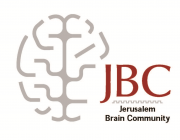Congratulations to Robert H. Goldstein for winning the June 2019 JBC SMART Brain Prize for the outstanding article: “Location and Plasticity of the Sodium Spike Initiation Zone in Nociceptive Terminals In Vivo”, published in Neuron in April 2019.
Robert is a 5t h year PhD candidate in Neurobiology in Prof. Binshtok Alex from the department of Medical Neurobiology. Robert is researching mechanisms of transduction, action potential initiation and plasticity, at the free nerve endings of nociceptors. He implements advanced imaging techniques, while recording noxious stimuli induced neuronal signals in peripheral nociceptive nerve terminals innervating the mouse cornea, in vivo and in vitro. Furthermore, these studies are accompanied with neuronal computational models for validation and behavioral assays for preclinical pathological significance.
h year PhD candidate in Neurobiology in Prof. Binshtok Alex from the department of Medical Neurobiology. Robert is researching mechanisms of transduction, action potential initiation and plasticity, at the free nerve endings of nociceptors. He implements advanced imaging techniques, while recording noxious stimuli induced neuronal signals in peripheral nociceptive nerve terminals innervating the mouse cornea, in vivo and in vitro. Furthermore, these studies are accompanied with neuronal computational models for validation and behavioral assays for preclinical pathological significance.

Figure 6. Scheme Depicting Capsaicin-Induced Signal Generation in Nociceptive Terminals and Fibers. Left: in normal conditions, application of capsaicin on the nociceptive terminal tip evokes activation of terminal TRPV1 channels, leading to Ca2+ entry and depolarization. The depolarization activates VGCCs, thus adding to capsaicin-induced Ca2+ signals. The Ca2+ signal and capsaicin-induced depolarization propagate along the terminal in a Nav-independent manner for ∼25 μm. This depolarization reaches a Nav-SIZ, the location of available Navs, where activation of Navs generates propagating action potentials, which propagate toward the CNS. Right: acute inflammation or application of proinflammatory mediators, presumably by virtue of their relieving effect on Nav slow inactivation, “shifts” the location of available Navs toward the terminal, enhancing the response to capsaicin, thus rendering the nociceptive terminal branch hyperactive.

